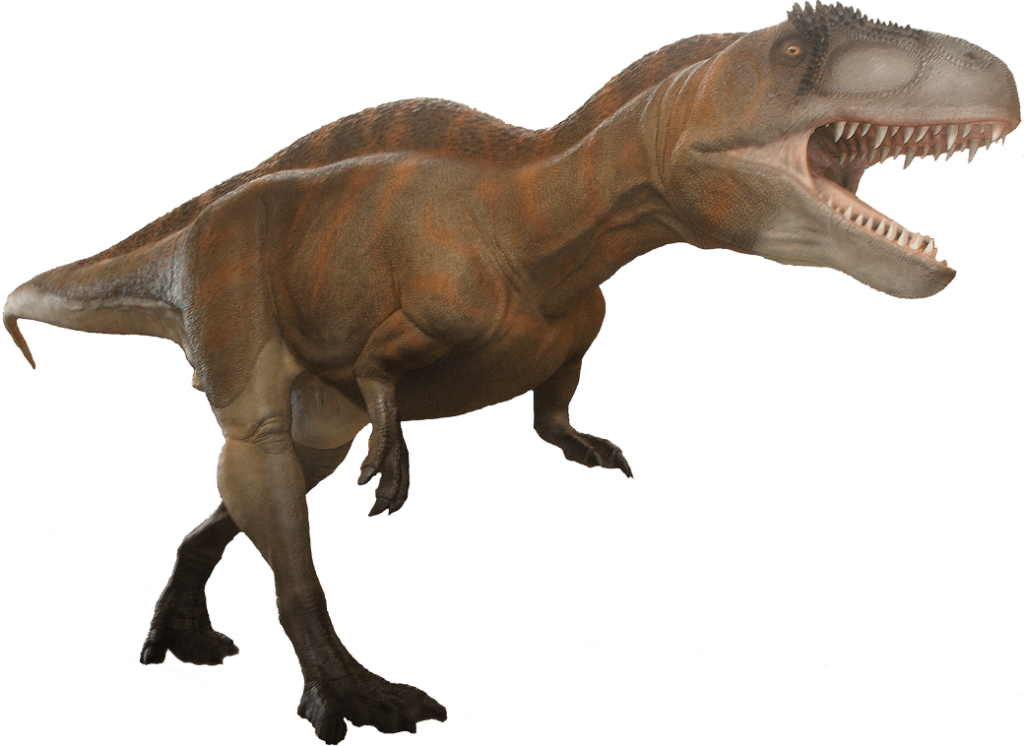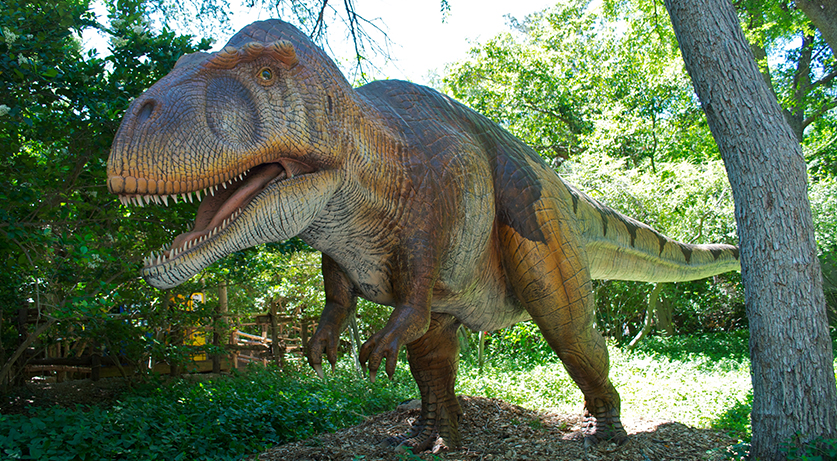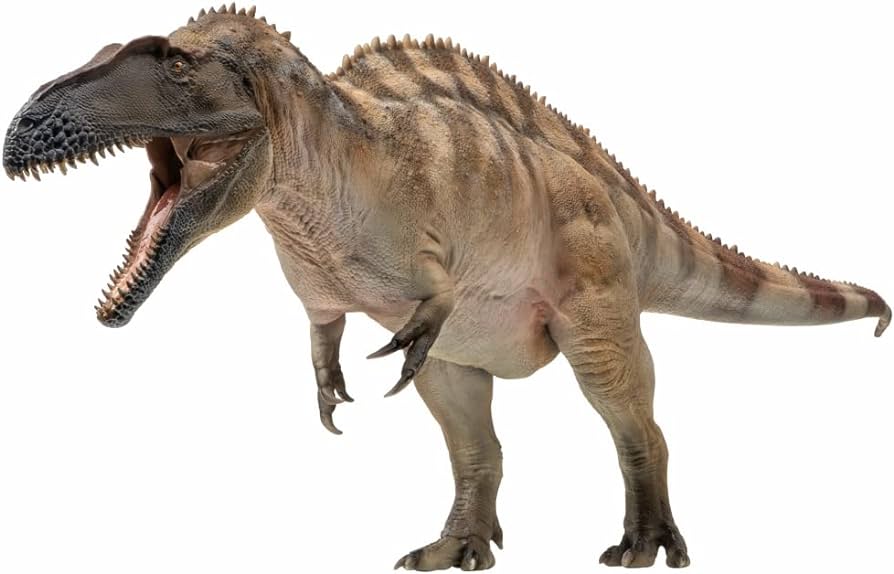Introduction
Dinosaurs have always held a special place in our fascination with prehistoric life. Among the diverse array of these ancient giants, Acrocanthosaurus stands out as one of the most intriguing and awe-inspiring.
With its towering presence and distinctive features, this magnificent dinosaur has captured the imagination of both scientists and dinosaur enthusiasts alike. Come along as we set out on an expedition to uncover the marvels of Acrocanthosaurus.
Key Attributes of Acrocanthosaurus

| Name | Acrocanthosaurus |
|---|---|
| Size | Approximately 11 to 12 meters (36 to 39 feet) in length |
| Age | Early Cretaceous (approximately 115 to 105 million years ago) |
| Diet | Carnivorous, primarily preying on large herbivorous dinosaurs |
| Classification | Kingdom: Animalia, Phylum: Chordata, Class: Sauropsida, Superorder: Dinosauria, Order: Saurischia, Suborder: Theropoda, Family: Carcharodontosauridae, Genus: Acrocanthosaurus |
| Habitat | Varied environments including forests and plains |
| Distribution | Found in North America, specifically in what is now the southern United States |
| Unique Features | Large size, elongated neural spines along its back, powerful jaws, and sharp teeth |
| Behavior | Apex predator, believed to be a skilled hunter of large prey |
| Prey | Likely hunted large herbivorous dinosaurs such as sauropods |
| Cultural Significance | Important in understanding the diversity of large theropod dinosaurs |
| Fossil Record | Well-preserved fossils discovered in North America, providing insights into its anatomy and behavior |
The Enigmatic Acrocanthosaurus
Boldly marked by its unique name and formidable appearance, Acrocanthosaurus has intrigued researchers for decades. Let’s explore this remarkable creature from the Mesozoic era.
Acrocanthosaurus: A Giant of Its Time
In the annals of dinosaur history, Acrocanthosaurus was undeniably a giant. With an estimated length of up to 40 feet and a weight of several tons, it roamed the earth during the Early Cretaceous period. Its sheer size and distinctive characteristics make it a focal point of paleontological study.
Acrocanthosaurus was a predator of immense proportions, standing as a testament to the incredible diversity of life during its era.
Physical Characteristics
Towering Spines
One of the most distinguishing features of Acrocanthosaurus is its towering spines along its back, which gave it its name. These long neural spines adorned its vertebrae, creating a unique profile that set it apart from other dinosaurs.

These spines, measuring up to 2 feet in height, remain a subject of fascination among paleontologists. They are believed to have served various purposes, from temperature regulation to display during courtship and dominance disputes.
Powerful Jaws
Acrocanthosaurus possessed a robust skull with formidable jaws armed with sharp teeth. These powerful jaws enabled it to hunt and feast upon a variety of prey, making it a fearsome predator of its time.
Recent studies of Acrocanthosaurus teeth have revealed microscopic wear patterns, shedding light on its dietary preferences and hunting strategies. Its specialized dentition allowed it to tackle large herbivorous dinosaurs effectively.
Habitat and Fossil Discoveries
As we delve into the world of Acrocanthosaurus, it’s essential to understand its habitat and the fossil discoveries that have provided valuable insights into its life.
Habitat
Acrocanthosaurus once roamed what is now North America, primarily in the region that includes present-day Oklahoma and Texas. It inhabited lush, riverine environments, where it likely pursued a diet composed of large herbivorous dinosaurs. These ancient landscapes, teeming with diverse flora and fauna, provided a rich tapestry for the life of Acrocanthosaurus.
Fossil Discoveries
The story of Acrocanthosaurus is pieced together from an array of fossil discoveries. Paleontologists have uncovered numerous skeletal remains and tracks, shedding light on this magnificent creature’s existence.
Among the notable finds are articulated skeletons, which have allowed scientists to reconstruct its posture and movements with greater accuracy. These fossils continue to provide valuable data, fueling ongoing research into Acrocanthosaurus’s biology and behavior.
Evolutionary Significance
The study of Acrocanthosaurus has not only enriched our understanding of dinosaurs but also contributed to our knowledge of evolution. Let’s delve into its evolutionary significance.
Carnivorous Adaptations
Acrocanthosaurus’s unique adaptations for carnivory, including its powerful jaws and serrated teeth, provide valuable insights into the evolution of predatory dinosaurs. The evolution of such specialized features allowed it to occupy a niche as a top-tier predator in its ecosystem.
Examining these adaptations helps us unravel the intricate web of predator-prey interactions in prehistoric times.
Taxonomic Classification
Acrocanthosaurus belongs to the theropod group of dinosaurs, a diverse lineage that includes famous species like Tyrannosaurus rex. Understanding its place within this group helps us unravel the evolutionary tree of dinosaurs. It was one of the most fearsome carnivorous dinosaurs of its time.
Recent advances in molecular and comparative genomics have shed light on the genetic relationships between Acrocanthosaurus and its theropod relatives. These studies contribute to our understanding of the broader patterns of dinosaur evolution.
The Enduring Legacy of Acrocanthosaurus
In conclusion, Acrocanthosaurus continues to be a source of fascination and inspiration for scientists and dinosaur enthusiasts worldwide. Its towering spines, powerful jaws, and imposing presence make it a remarkable figure in the annals of prehistory.

Through fossil discoveries and ongoing research, we continue to unveil the secrets of this incredible dinosaur, adding to our understanding of Earth’s ancient past.
Exploring the Myths and Legends
Throughout history, humans have woven myths and legends around creatures like Acrocanthosaurus. These stories reflect our enduring fascination with the prehistoric world.
Cultural Depictions
Acrocanthosaurus has made appearances in literature, movies, and art, becoming a symbol of prehistoric power and mystery. Artists and writers have drawn inspiration from its unique features to create captivating works that transport us back to the age of dinosaurs.
Paleontological Pioneers
Learn about the dedicated scientists and paleontologists who have dedicated their lives to uncovering the secrets of Acrocanthosaurus and other dinosaurs. Their tireless efforts in the field of paleontology have expanded our knowledge of prehistoric life and its significance in the broader context of Earth’s history.
Acrocanthosaurus in Popular Culture
The allure of Acrocanthosaurus extends beyond the scientific community. Its presence in popular culture showcases its enduring appeal.
Books and Novels
From gripping novels to informative non-fiction, discover the books that bring Acrocanthosaurus to life. These literary works often blend scientific accuracy with creative storytelling, offering readers an immersive experience in the world of dinosaurs.
Movies and Documentaries
Explore the cinematic representations of Acrocanthosaurus in documentaries and blockbuster films. Filmmakers have used cutting-edge technology to recreate the prehistoric landscapes and creatures, bringing the world of Acrocanthosaurus to the big screen.
Collectibles and Merchandise
For avid collectors and enthusiasts, there’s a world of Acrocanthosaurus-themed merchandise to explore, from action figures to clothing. These collectibles allow fans to celebrate their passion for dinosaurs and share their love for Acrocanthosaurus with others.
The Ongoing Quest for Knowledge
The study of Acrocanthosaurus is far from over. Ongoing research and discoveries continue to enrich our understanding of this remarkable dinosaur.

Recent Discoveries
Stay updated on the latest findings and breakthroughs in Acrocanthosaurus research. Scientists continue to make exciting discoveries that reshape our understanding of this dinosaur’s biology and behavior. New fossil specimens and advanced scientific techniques offer fresh insights into its world.
Conservation Efforts
While Acrocanthosaurus is long extinct, its fossils and the habitats it once roamed are still worth protecting. Learn about efforts to preserve the legacy of this iconic dinosaur and ensure that future generations can marvel at its remains. Conservationists work tirelessly to safeguard fossil sites and promote the study of prehistoric life.
Conclusion
As we conclude our journey through the captivating world of Acrocanthosaurus, we are left with a profound appreciation for this incredible dinosaur. From its towering spines to its powerful jaws, Acrocanthosaurus has left an indelible mark on our understanding of Earth’s ancient past.
We look forward to the ongoing discoveries and adventures that await in the field of paleontology, where the mysteries of prehistoric life continue to unfold.
FAQs
How did Acrocanthosaurus get its name?
Acrocanthosaurus derives its name from the Greek words “akros,” meaning high or tall, and “akantha,” meaning spine. This name alludes to its prominent dorsal spines, a striking feature that sets it apart from other dinosaurs.
What did Acrocanthosaurus eat?
Acrocanthosaurus was a carnivore, preying on large herbivorous dinosaurs like sauropods and ornithopods. Its robust jaws and serrated teeth were adapted for slicing through the tough flesh of its prey.
When did Acrocanthosaurus exist?
Acrocanthosaurus lived during the Early Cretaceous period, approximately 115 to 105 million years ago. This period marked a time of great ecological diversity, with various dinosaurs coexisting.
How large was Acrocanthosaurus?
Adult Acrocanthosaurus individuals could reach lengths of up to 40 feet and weighed several tons, making them formidable predators in their ecosystem.
What is the significance of Acrocanthosaurus in paleontology?
Acrocanthosaurus holds significance in paleontology due to its unique dorsal spines, which have sparked scientific interest and discussions about their purpose. Additionally, its role as a top predator of its time informs our understanding of ancient food chains and ecosystems.
Are there any living relatives of Acrocanthosaurus today?
No, Acrocanthosaurus went extinct millions of years ago, and there are no living relatives of this magnificent dinosaur. However, its legacy lives on through the study of its fossils and contributions to our understanding of Earth’s ancient history.
